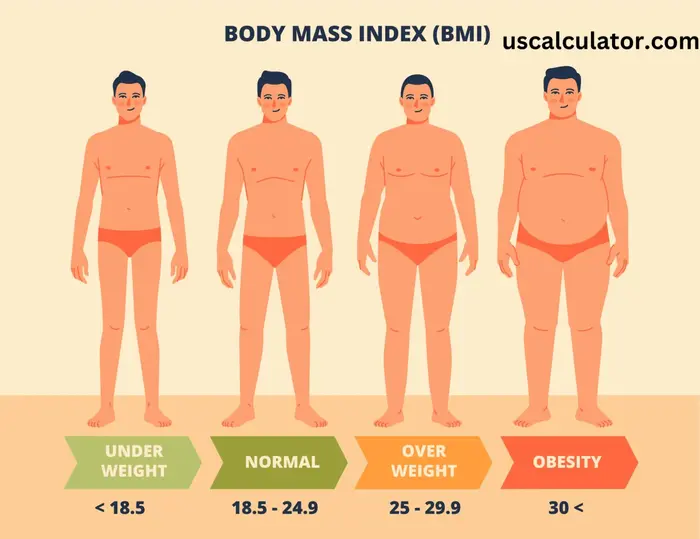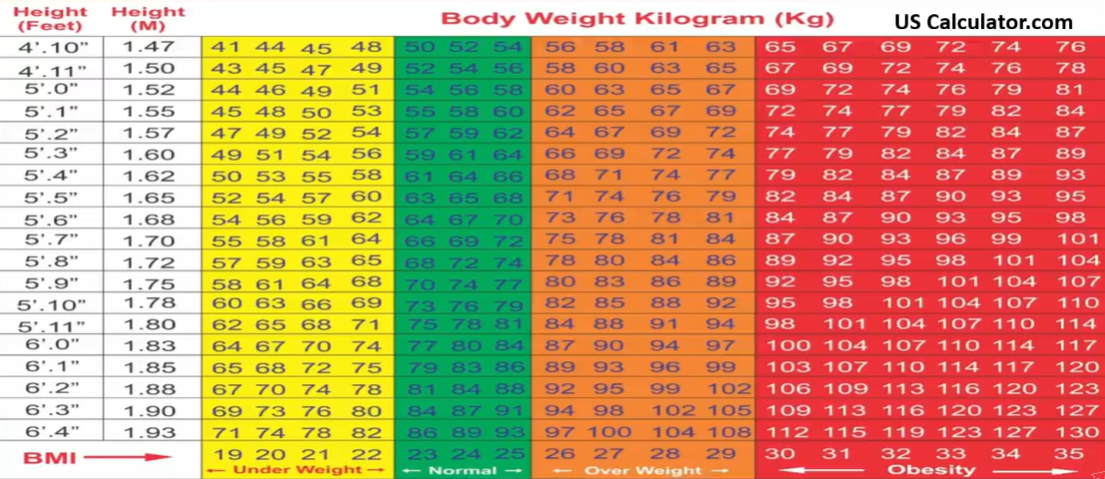BMI Calculator
The BMI Calculator (Body Mass Index) is an instrument developed to provide information regarding the total body weight level in connection with height. It offers two systems of units: Imperial, which are feet, inches, and pounds, and metric measures such as centimeters, meters, and kilograms. Some users input their height and weight and select the right product.
The BMI calculator in turn computes the BMI, BMI group, BMI prime, amount above/below the limit, and then the result, including the controversy, with a graphical line risk level including all-cause mortality based on the BMI that aids in interpreting the weight status and possible healthy index of a person.
Share Calculator
Common Calculators | |
Table of Contents

Introduction of BMI
Have you ever heard of BMI? It's like a quick test to see if your weight is healthy for your height. Think of it as an estimate, not a perfect science. However, it can be helpful to know when to consult a doctor about your weight.
Based on a person's height and weight, BMI calculates leanness or heaviness and is used to define tissue mass.
See the table below to see several BMI-based categories used by BMI calculators.
The body mass index, or BMI, is a simple but widely used tool for assessing whether a person's body weight is healthy in proportion to their height. It's a number that can give you a quick image of your status—whether you're in the healthy weight range, underweight, overweight, or obese. As a high school student, I heard about BMI in health class, and it's Incredible how a simple calculation can tell us so much about our health. In this article, I'll explain what BMI is, how it's calculated, what these numbers mean, and why it's not the whole story when it comes to health. I'll also go into detail about related concepts like the BMI prime and ponderal index, as well as the risks of being overweight or underweight. Let's get started!
BMI- What is it?
BMI stands for body mass index, which is simply a figure indicating whether the weight you have is good in respect to your height. It dates back to the 1800s when it was invented by a Belgian professor by the name Adolphe Quetelet as a quick means of determining whether a person was of a healthy weight or not without the use of extremely expensive gadgetry. Even today, doctors, fitness trainers, and even schools all resort to BMI to identify underlying health issues when they are still in their early stages. It is not flawless (we are going to discuss this later), but this is a nice beginning in case you want to know how your weight would match your height.
This is one of the cool things about BMI because it applies to most adults regardless of their gender, and it is easy to compute. It is also used to enable the researchers to monitor the trends existing in a group of individuals, such as the increasing levels of obesity in some countries. As students of our age, the knowledge of our BMI can assist us in making improved decisions regarding what we consume, whether we exercise at all, and how healthy we are.
BMI calculation formula
The BMI formula is super simple, and you can do it with just a calculator. There are two versions of the formula, depending on whether you're using metric or imperial units:
Metric Formula:
BMI = weight (kg) ÷ (height (m))²
That's your weight in kilograms divided by your height in meters squared.
| BMI = |
| |||
Imperial Formula:
BMI = (weight (lb) ÷ (height (in))²) × 703
Here, you divide your weight in pounds by your height in inches squared, then multiply by 703 to adjust for the units.
| BMI = |
| |||
| × 703 |
BMI calculation Example
Imperial unit Example
Let's say I'm a high school student who weighs 150 pounds and is 5 feet 6 inches tall. How do I calculate my BMI? First, I need to convert my height to inches. Since 5 feet equals 60 inches, plus 6 more inches, my total height is 66 inches. Now, I plug it into the imperial formula:
BMI = (150 ÷ (66)²) × 703
BMI = (150 ÷ 4356) &$215; 703
BMI = 0.03444 × 703
BMI = 24.2
So, my BMI is about 24.2. But what does that number mean? Let's look at the BMI categories to find out.
Metric unit Example
Let's say I'm a high school student who weighs 70 kg and is 1.75 meters tall. How do I calculate my BMI?
BMI = (75 ÷ (1.75)²)
BMI = (75 ÷ 3.0625)
BMI = 22.8571
So, my BMI is about 22.8571. But what does that number mean? Let's look at the BMI categories to find out.
6ft height, 70 kg weight. BMI calculation example.
Let's say I'm a high school student who weighs 70 kg and is 6 feet (which is equivalent to 1.8288 meters) tall. How do I calculate my BMI?
| BMI = |
| |||
(1.8288m)2 = 3.3449 m2
| BMI = |
| |||
Finally, calculate the result: BMI = 20.9
So, the BMI for a person with a height of 6 feet and a weight of 70 kg is approximately 20.9. BMI

BMI Table for Adults
BMI is divided into categories that indicate whether you're underweight, healthy, overweight, or obese. Here's a table for adults (ages 20 and up):
| BMI Range | Category |
|---|---|
| Below 18.5 | Underweight |
| 18.5 - 24.9 | Normal Weight |
| 25.0 - 29.9 | Overweight |
| 30.0 and above | Obese |
Using my example, a BMI of 24.2 falls in the “Normal Weight” range, which means I'm in a healthy weight category. These ranges are based on studies that link BMI to health outcomes, like the risk of heart disease or diabetes.
Risks of Being Underweight
Being underweight (a BMI that is less than 18.5) may create health issues. I would find other students missing meals to be able to stay thin; however, this is not always good. This is the reason why being underweight is risky:
Lack of sufficient nutrients may also complicate the task of your body to resist infections, which is why a weak immune system can also be discussed as nutrient poverty.
Once the weight goes below the healthy limit, the muscle mass is also likely to decrease. That can leave you with feet dragging or weakness.
Underweight, especially in women, is also accompanied by weaker bones sometimes. Due to that, several underweight individuals have weak bone density and hence the increased possibility of the development of osteoporosis in the future.
Fertility Problems: For girls, being underweight can interfere with menstrual cycles, and as such, makes it more difficult to conceive later on.
Growth holds: For people like me who are teens, being underweight can hold back growth and body development.
If you are underweight, talking to a doctor or a nutritionist can help you find ways to boost your weight gain with the help of healthy food.
Special BMI Chart

Risks of Being Overweight
Being overweight or being obese is not about appearance. It has the potential to expose our bodies to grave danger from various health challenges. I am a high school student, and my experience as one has taught me that extra weight may have significant effects on us. These are the principal risks:
1. Diabetes type 2. Living as overweight or obese, our body adapts to insulin resistance, that is, it does not use insulin so well. With time, it may result in the development of type 2 diabetes, which is a condition in which the level of blood sugar remains elevated.
2. Increased blood pressure. As long as we are overweight and obese, our hearts will be required to work harder to circulate the blood within our bodies. An additional work can increase our blood pressure.
3. Heart disease. All those additional activities that our hearts perform can tire them out, causing an increased risk of heart disease.
4. Stroke. Just like heart disease, the added strain on the body by our blood vessels may result in the formation of plaque, producing a narrowing of the arteries. When it occurs, the blood clots may arise, preventing the flow of blood to the brain and leading to a stroke.
5. Sleep apnea. When we sleep, the accumulation of fat overcrowds the airway, causing difficulty in breathing. It may cause sleep apnea, which is associated with pauses in breathing during the night.
6. Arthritis. The added weight exerts added pressure on our joints and bones, particularly the knees and the hips. Such additional wear and tear may lead to arthritis with time.
7. Certain cancers. Obesity and being overweight predispose us to some cancer types, which include cancer of the breast, colon, endometrium, and pancreas.
What Is BMI Prime?
Another lesser-known concept is BMI Prime, which is the comparison of your BMI to the highest score of the healthy (24.9). To obtain it, you take your BMI and divide it by 24.9. As an example, when my BMI is 24.2, then my BMI Prime is 24.2 ÷ 24.9 = 0.097.When you check your BMI Prime
Basically, what that means is your BMI is adjusted based on height, and when that value is less than 1, then you are in the healthy range. Once it exceeds 1, you are overweight or obese. Many do not discuss the topic of BMI Prime, yet I find it quite interesting to understand how close you are to the normal weight. It is sort of like a report card of BMI, to me.
| Classification | BMI(kg/m2) | BMI Prime |
|---|---|---|
| Severe Thinness | < 16 | < 0.64 |
| Moderate Thinness | 16 - 17 | 0.64 - 0.68 |
| Mild Thinness | 17 - 18.5 | 0.68 - 0.74 |
| Normal | 18.5 - 25 | 0.74 - 1 |
| Overweight | 25 - 30 | 1 - 1.2 |
| Obese Class I | 30 - 35 | 1.2- 1.4 |
| Obese Class II | 35 - 40 | 1.4 - 1.6 |
| Obese Class III | > 40 | > 1.6 |
What Is the Ponderal Index?
Another method of measuring weight in comparison with height is the Ponderal Index (PI), which is slightly different in operating than BMI does. First of all, you need to memorize the formula and then do the following:
PI = weight (kg) ÷ (height (m))³
With the BMI, you always do it by squaring the height, in the PI cubing it. Due to it, the PI is even more sensitive to the height of the person, especially when they are a very tall or a very short person.
An example is as follows: a person has a weight of 70 kg and he/she is 1.7 meters.
PI = 70 ÷ (1.7)³
PI = 70 ÷ 4.913 = 14.25 kg/m³
PI-planetary index can also be referred to as a term you can learn in science classes, yet another variation of it is called the BMI, and you know what that term is. Although most individuals use BMI as the preferred measurement of keeping track of their weight, PI is also sometimes employed in the case of children and those who are exceptionally tall, since it is used in cases involving abnormal heights. Normal PI is about 11 - 14 kg/m³, though it may differ according to the individual.
Limitations of BMI
BMI comes in handy, but it is not flawless. My lesson in health class was that BMI does not give you the entire picture as regards your health. Some of the limitations are as follows:
BMI is unable to distinguish between fat and muscle. A bodybuilder may have a BMI scale that counts as high since he or she is lifting weights, although he or she may be slim.
BMI does not consider the age, gender, or composition of the body. A girl who is tall with big shoulders and a low-fat threshold may be showing a higher BMI than a short girl with more fat. This is not fair.
BMI does not provide any measure of actual health. It does not read the amount of cholesterol and blood sugar levels, which are good pointers to the general health.
Fitness is not measured in terms of BMI. It does not tell you the level of fit you are; it simply tells you the amount of weight per height.
In a nutshell, BMI is useful but does not represent the whole picture of your health.